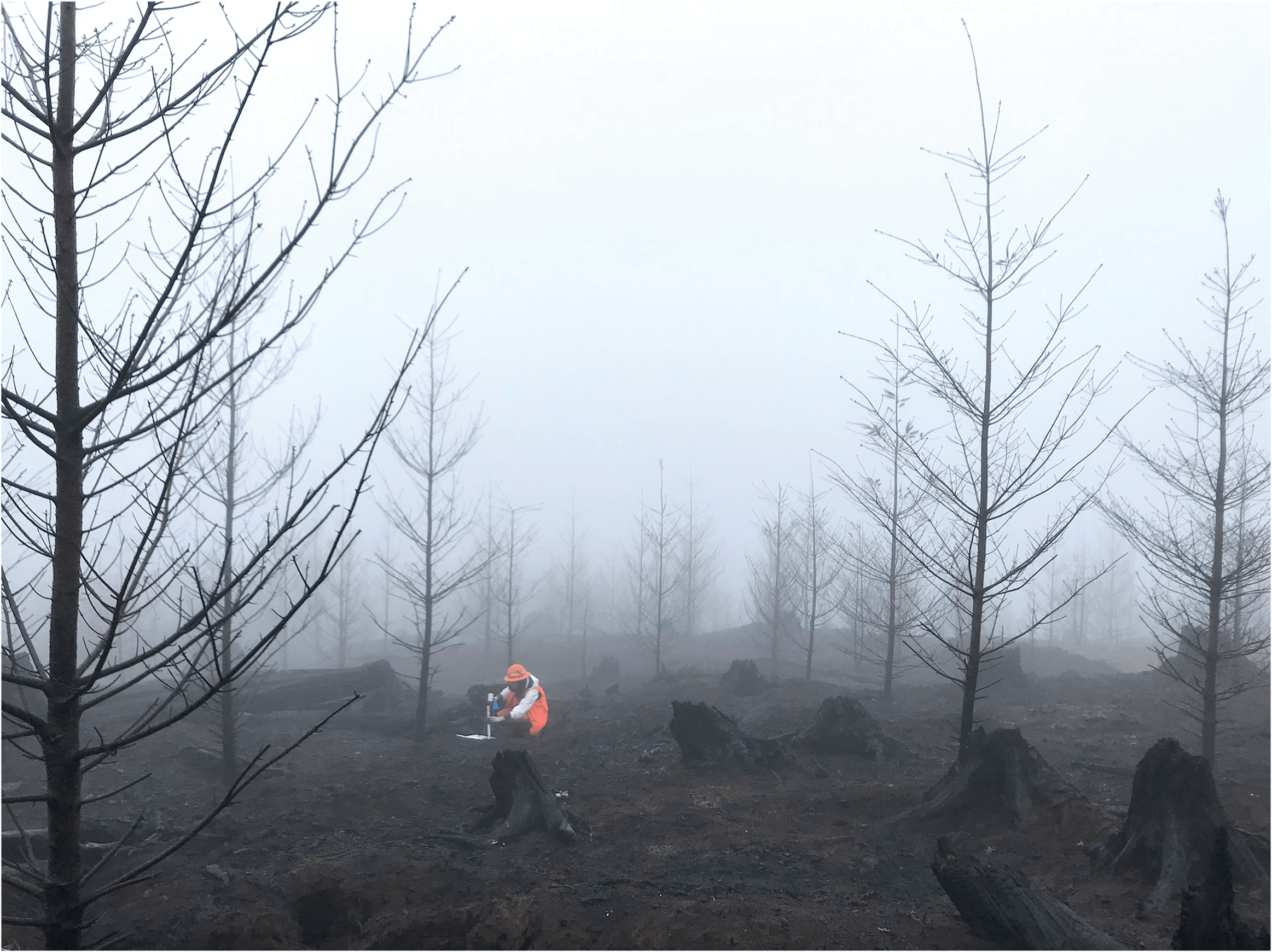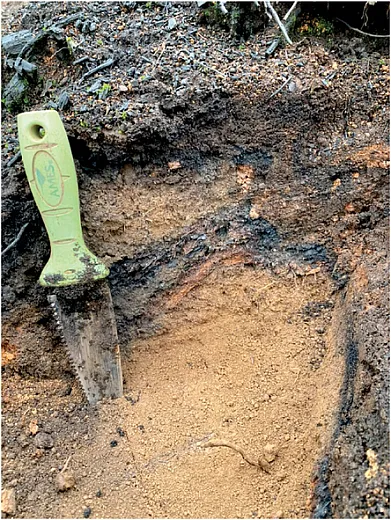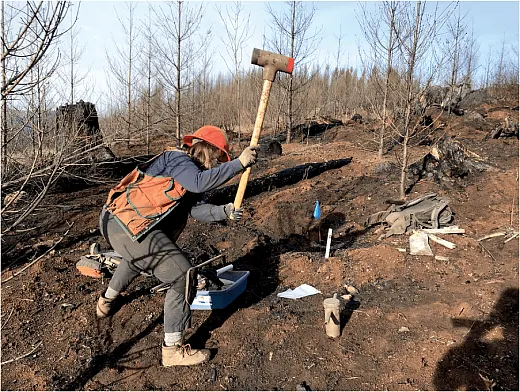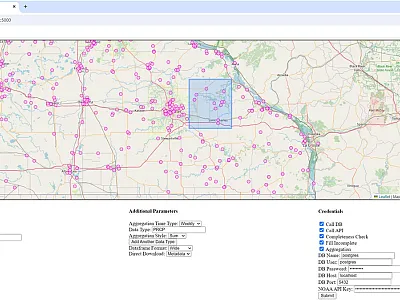Burning Questions
Pre- and Post-Wildfire Soil Sampling in Western Cascades Tree Farm Reveals Large-Scale Soil Carbon Loss

The world's temperate forests, such as those occurring on the western slopes of the Cascade Mountains in Oregon, are estimated to hold 500 gigatons of carbon (C). These forests are critical to the world's C storage and the global C cycle.
Western forests are facing more frequent and more intense wildfires because of rising global temperatures; increasing frequency, length, and intensity of drought; and in many places, decades of fire suppression policy. Climatic and land use variables contribute to wildfire risk.
A recently published article in the Soil Science Society of America Journal (SSSAJ) (https://doi.org/10.1002/saj2.20582) described the results of an unusual opportunity to quantify the effects of a high‐severity wildfire on soil carbon and nitrogen (N) using pre‐ and post‐fire intensive soil sampling of a managed Douglas‐fir tree farm in the western Cascades of Oregon.
Pivot to Pre‐ and Post‐Burn Study
A research team first sampled the research site in 2010 as part of a larger look at impacts of harvesting on forest soil C at nine sites in western Oregon and Washington. The team was led by SSSA members Jeff Hatten, professor of forest engineering, resources, and management at Oregon State University, and Scott Holub, forest soil scientist, at forest products company Weyerhaeuser. The Weyerhaeuser‐owned site lies on the western, wet side of the Cascade Mountains in Oregon, near the town of Leaburg.

The site burned during a high‐severity wildfire in September 2020, one of the so‐called Labor Day fires that kicked up in high winds out of the east‐northeast on September 7 and went on to burn more than 800,000 acres in Oregon. The study site was burned by the Holiday Farm fire.
After the wildfire, the team pivoted quickly to a pre‐ and post‐burn study at this site, recognizing the unique opportunity to answer questions about wildfire effects on soil C afforded by their pre‐burn soil samples and marked soil sampling locations.
“We don't have a lot of studies with pre‐fire data,” Hatten says. “When we have this opportunity, we need to take it.”
The site had unusually severe impacts because the trees were young—10 to 20 ft at nearly eight years old—with harvest residues on the ground. “This might be a worst‐case scenario for soil,” Hatten says, because smaller trees burn hotter and more closely to the soil. A fire of this size and severity is unusual in this normally wet area. A high‐severity burn means high mortality of trees and removal of soil layers.
A 2022 Oregon Department of Forestry report on the fires states that “much of Oregon [was] experiencing drought conditions and historically low fuel moistures and relative humidity” before the fires.
Soil sampling at the site sheds light on what happens in the short and long term with multiple disturbances—both harvest and wildfire. The findings from this research can help industrial tree farm managers in this area determine potential impacts on soil health after severe wildfire that may lead to future effects on tree productivity.
Intensive Soil Sampling
Katherine McCool, an SSSA member and master's student at Oregon State University, sampled the site post‐fire from December 2020 to April 2021, three to seven months after the fire. She grew up in Washington, DC, so this was the first wildfire aftermath she'd seen. It was “overwhelming,” she admitted—“a surprising extent of devastation.” The forest floor material was completely gone, leaving just the blackened mineral soil surface.
Hatten, Holub, and colleagues set up the study plots and sampled soils in 2010. Harvest occurred in 2011 and replanting in spring 2013. They resampled soils in 2015. This study reflects the effects of fire and the harvesting nearly nine years previous.
Each site in the original study was 10–15 ac with about 300 sample points about 12 m apart. The intensive soil sampling “was designed to be statistically sensitive,” Hatten says.
Original sample locations were marked with PVC pipe and metal tags. On resampling after the fire, McCool and colleagues found that most of those markers were buried or combusted, but they used the sample plot design to determine where to resample. They sampled the forest floor layer and then used a metal core to collect samples between 0 and 15 cm and between 15 and 30 cm deep.
The team measured indicators of overall forest health, including C stock, soil mass, C concentration (%C), N concentration (%N), C:N ratio, N stock, and dry bulk density. These parameters may influence site productivity after disturbance.
They analyzed both woody and nonwoody forest floor litter, so they could determine different effects on each by the wildfire. They included analysis of larger soil particles than is typically done for soil C and sieved soil into size fractions. This allowed them to assess total C changes after wildfire and to detect different effects of fire on the mineral soil particle size classes.
Surprising Amount of Soil Carbon Lost
The team found significant changes in forest floor and soil C stocks after wildfire. Carbon stocks were approximately 40 Mg C ha–1 lower post‐fire. The forest floor saw two‐thirds of C decreases, and overall mass decreased by 95%.
“This was a very, very severe impact on the soil,” Hatten says. “What struck me was how much the mineral soil decreased and where it decreased.” The literature typically indicates fire effects in the top few centimeters. But this study found that about 11% of the C stock lost came from 15 to 30 cm down. This may indicate the need to regularly sample more deeply in burned soils because effects may lie deeper than expected.

Most C loss in the subsoil was driven by a decrease in bulk density, which could have been due at least in part to erosion downslope. Most forest soil studies have found an increase in soil bulk density with wildfire as soil clumps together.
The study did not ascertain where lost soil C went although McCool's ongoing Ph.D. work is attempting to find out on another site that burned in the Labor Day fires. Besides erosion, soil may have been carried off by the strong winds that drove the fire, and C was probably lost largely in smoke.
In a mature forest, tree limbs are higher up than they were in this young forest, contributing to the burn severity and likely making the soil C loss larger and deeper than Hatten expected.
The results on the loss of C from the forest floor and from surface mineral horizons “follow along with data” that Deborah Page‐Dumroese and her group has collected from slash pile burning. Page‐Dumroese is an SSSA member and senior research soil scientist with the U.S. Forest Service in Moscow, ID. These results also mesh with the findings of the more than 30‐year North American Long‐Term Soil Productivity Study, which seeks to measure the effects of soil disturbance on forest productivity and changes in soil processes. “Maybe we should be paying more attention” to the effects of severe wildfire on forest soils and their ability to continue to support trees, Page‐Dumroese says.
Nitrogen has a higher volatilization temperature than carbon, so N tends to change more slowly than C, leaving the soil with a lower C:N ratio. The researchers found the expected pattern—less N was lost than C. They found increases in N at some sampling points.

Implications for Global Carbon Management
This study has important implications for global C management and efforts to sequester C in forests to fight climate change. Tree planting has seemed like an effective strategy, but seedlings and young trees are more likely to burn than mature trees, releasing at least some of their stored C into the atmosphere.
Compounded stressors such as wildfire, harvest, and insect infestation will change forests, Hatten says, and “a good chunk of our terrestrial carbon pools are locked up in the soil. So it's really important to understand how these changes add up and impact the soil, particularly soil carbon when it comes to climate change.”
The western Cascades area has not typically been subject to high‐severity wildfire, but previous research has found that areas burned with high severity tend to do so again, indicating that an ecosystem transformation may occur. However, the findings that C concentration did not change and N concentration was higher overall after the fire may suggest some forest resiliency at this site.
Evers and colleagues at Portland State University in Oregon recently published a satellite data–driven study (https://doi.org/10.3390/fire5020041) that identified low canopy height and private land ownership as two of the largest drivers of high burn severity in the 2020 Labor Day fires. This means that industrial tree farms may lead to higher burn severity and more extreme ecosystem effects in wildfire.
“A good chunk of our terrestrial carbon pools are locked up in the soil. So it's really important to understand how these changes add up and impact the soil, particularly soil carbon when it comes to climate change.”
More Study Needed on Compounding Effects of Harvest and Fire
The uniqueness of the pre‐ and post‐fire sampling makes the site ripe for additional research. Hatten and Holub are making plans to resample the site, but they're not sure yet about the details. They feel that the unexpectedly high post‐fire %C at 15–30 cm deep requires further study. Previous research has typically reported across‐the‐board decreases. Increases could indicate longer‐term C storage.

Page‐Dumroese would like to see resampling at the site in the future to look at recovery not only of chemistry, including soil cations, but also microbial populations and belowground nutrient cycling to assess the long‐term ability to support tree growth.
Further study of the drivers of post‐fire soil C changes is needed, so we can adapt landscapes to withstand climate change and increasing fire frequency while maximizing soil C storage. Long‐term analysis of soil C at a site such as this may be able to separate changes into fire‐induced, harvest‐induced, and interactive causes. Studying soil C long term on sites with a variety of management landscapes, including beetle‐killed and non‐clear‐cut‐harvested sites, will help identify actions that may preserve soil C after a severe wildfire.
How Does Wildfire Typically Affect Soil?
A severe fire such as occurred at the study site burns all the soil organic matter on the forest floor. A low‐severity fire partially scorches the forest floor. The study site fire left 100% mortality of trees on the site.

Fire produces biogeochemical effects on forest soils:
Biologically, fungi and microorganisms typically die, but they rapidly recolonize a site.
Physically, previous research typically leads us to expect a collapse of soil, leading to increased bulk density, but at this site, the research team found decreased bulk density. The Labor Day fires were driven by sustained winds of 20–30 mph with gusts up to 50–60 mph, which may have lifted fine soil particles offsite, or they may have eroded downslope.
Chemically, we expect transformation of C into pyrogenic forms—those produced by fire—which tend to be less accessible to microorganisms and, therefore, to trees. This could be helpful for global C storage in combatting climate change.
Wildfire often leaves behind a hydrophobic layer in soil, which we typically expect about 5 cm deep in the soil. At the study site, it occurred at varying depths of 5–10 cm.
DIG DEEPER
View the original research: McCool, K.D., Holub, S.M., Gao, S., Morrissette, B.A., Blunn, J.E., Gallo, A.C., & Hatten, J. A. (2023). Quantifying impacts of forest fire on soil carbon in a young, intensively managed tree farm in the western Oregon Cascades. Soil Science Society of America Journal, 87, 1458–1473. https://doi.org/10.1002/saj2.20582
Text © . The authors. CC BY-NC-ND 4.0. Except where otherwise noted, images are subject to copyright. Any reuse without express permission from the copyright owner is prohibited.







